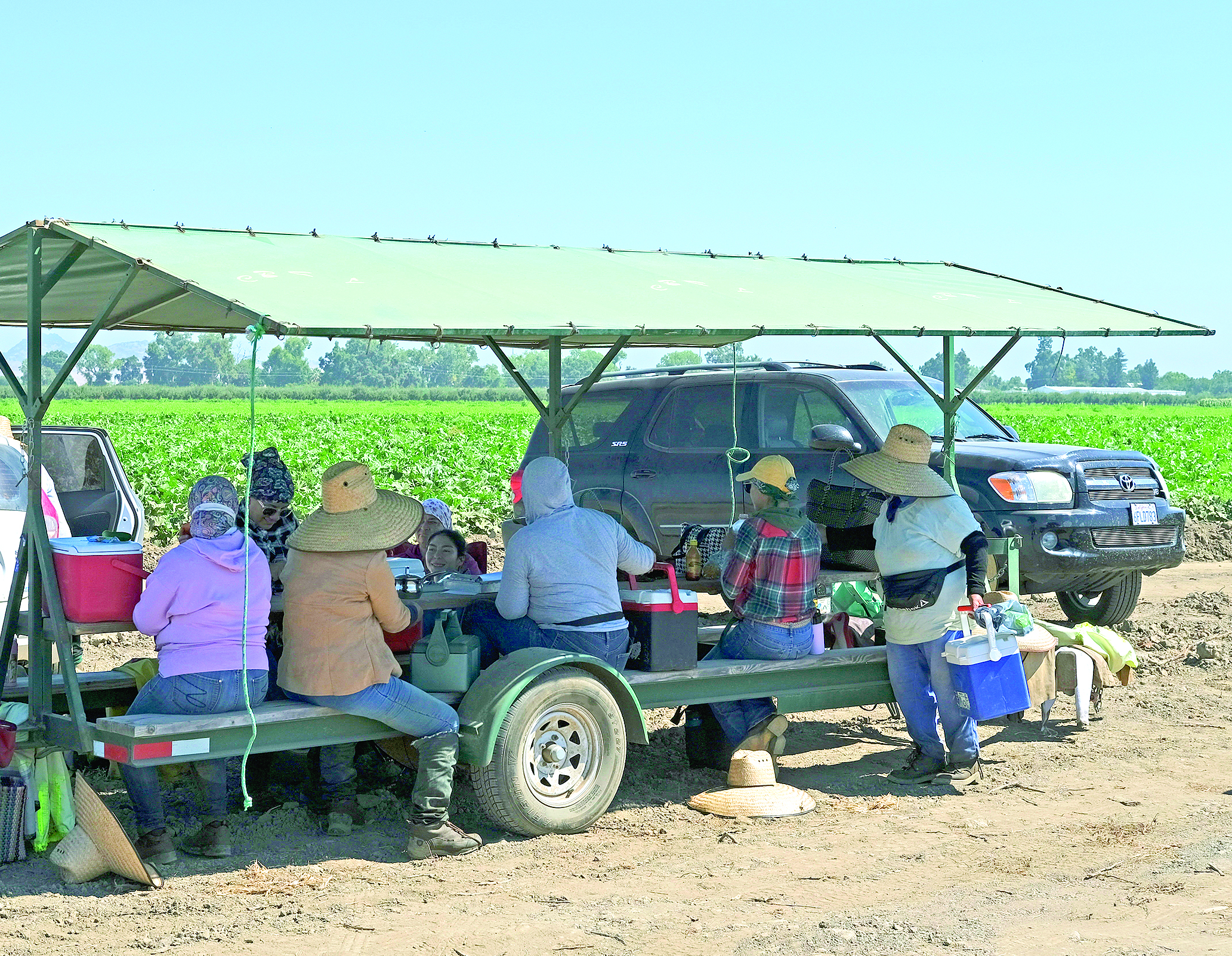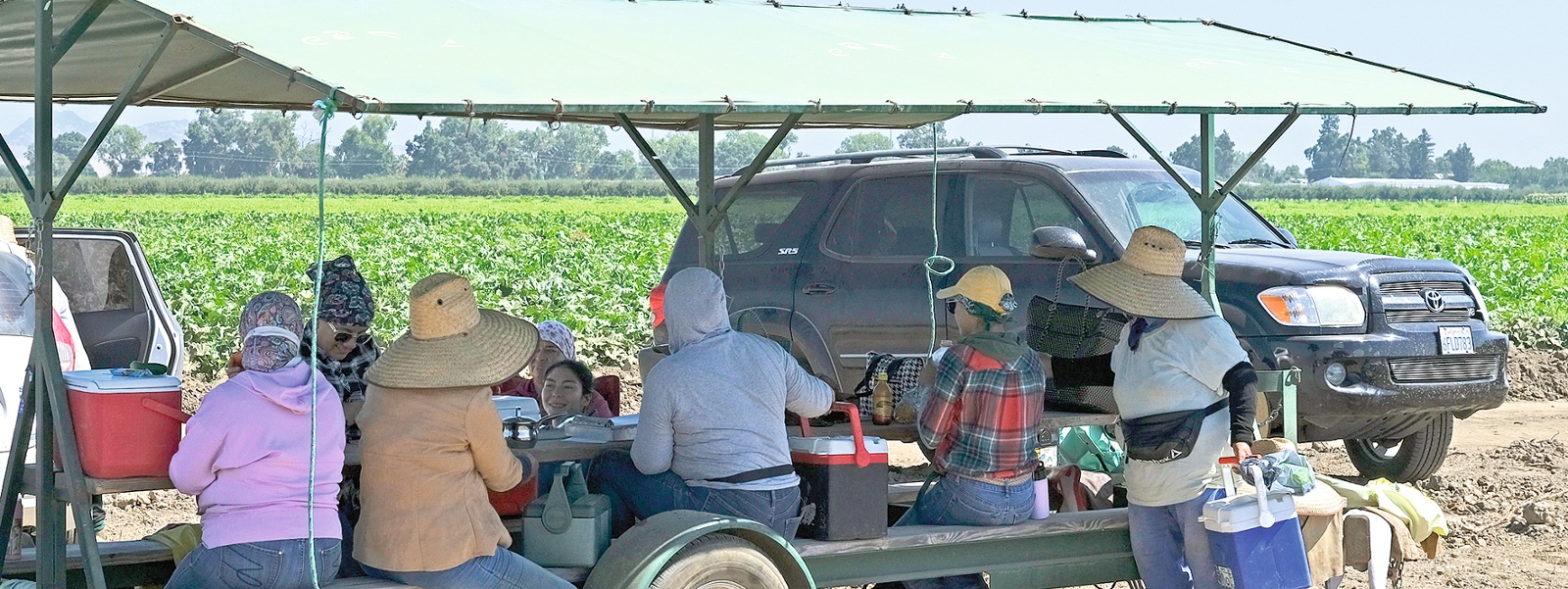Farms focus on safety amid summer heat

Agricultural employees take a break under a shade trailer at a Colusa County squash field earlier this month. California law requires employers to provide shade, water and rest when temperatures exceed 80 degrees. Farms should also have systems in place for contacting emergency personnel.
Photo/Caleb Hampton


Photo/Caleb Hampton
By Caleb Hampton
By the time the sun rose over the Sutter Buttes, Leticia Hermosillo and the 22-woman work crew she supervises were knee-deep in a Colusa County squash field, separating male and female plants that farmer Mitchell Yerxa grows for seed.
As the day grew hotter, the women sipped water from bottles hanging at their waists. Hermosillo stationed an orange cooler at the end of a row for refills. Next to the field stood a pair of porta potties and a line of trucks holding more drinking water. A shade trailer—a picnic table and awnings anchored to a flatbed trailer—offered an escape from the sun during breaks.
“That’s how we take care of ourselves and take care of each other,” Hermosillo said.
Every summer, caravans of shade and water line California’s fields, orchards and vineyards, providing heat relief for workers harvesting crops.
Compared to other states, “you definitely notice a difference,” said Angelina Ceja, vice president and chief education officer for Modesto-based AgSafe, which provides heat-safety training for farm labor contractors.
In 2005, following farmworker deaths in the Central Valley, California established the nation’s first heat-safety law for outdoor workers. Since then, California has tightened its Heat Illness Prevention Standard, which remains the most stringent of the few such state laws in effect.
The law includes requirements for shade, water and rest when the temperature rises above 80 degrees. It also mandates an acclimatization process for workers and a reliable line of communication between farms and local emergency services.
“The standards are pretty comprehensive,” said Kent Pinkerton, director of the Western Center for Agricultural Health and Safety and professor of pediatrics at the University of California, Davis, School of Medicine. “California has really taken the issue to heart to make sure that workers are protected.”
Now, after intense heat waves swept much of the country, Democratic lawmakers have introduced bills to direct the Occupational Safety and Health Administration to create an interim national heat-safety standard.
As rising temperatures prompt a push to enact workplace heat-safety laws, California farms offer a picture of what job sites may soon look like throughout the country and across industries.
“We’ve been doing this for a long time,” said Joe Del Bosque, who has farmed in the Central Valley since 1985. “We’re more aware—and we’re trying to make our employees more aware—of these dangers and how to protect themselves.”
During the summers, Del Bosque employs around 150 people to pick and pack melons on his Fresno County farm where the daily high temperature often reaches triple digits.
“The first thing we do is to start as early as possible,” he said. That’s typically around 6 a.m., as soon as it’s light enough to work, with the shift ending at 2:30 p.m. “By the hottest part of the day,” he said, “the workers have left.”
Bryan Little, director of labor affairs for the California Farm Bureau and chief operating officer of Farm Employers Labor Service, a Farm Bureau affiliate, said the logistics of heat-illness prevention for farmworkers requires careful preparation.
Farmers and crew leaders must have plans for keeping water coolers close to crews that move across fields, for transporting shade, water and other equipment on small dirt roads and for contacting emergency personnel in rural areas without reliable cellphone reception.
“There are so many logistical challenges you have to figure out when operating a farm,” Little said. “But in this case, if you mess it up, somebody could be seriously ill or worse. That elevates the level of priority.”
For melon harvest, Del Bosque employs someone to drive around the fields in a truck full of water and ice. Old cotton trailers, once used to haul the crop to cotton gins, have been outfitted with benches and awnings to serve as mobile rest areas.
While farmers and labor contractors are responsible for equipment and logistics, preventing heat illness in the field also depends on crew supervisors maintaining a safe environment for workers.
“They’re the ones that are responsible for the work to get done, and they also have a huge responsibility to ensure the workers are safe,” said Ceja of AgSafe. “They play a key role.”
Each year, crew supervisors on Del Bosque’s farm complete a two-hour heat illness prevention course, and Del Bosque conducts a 30-minute training with field workers on how to recognize the symptoms of heat illness.
“You see a lot more focus on health and wellness and training and retraining,” said Yerxa, the Colusa County farmer. “It’s not just about having the shade trailers, but making sure that the crew leaders are aware everyone needs to have proper hydration or whatever it is in that moment.”
Last week, Hermosillo, the Colusa County crew leader, walked along the rows of squash, doublechecking the weather forecast on her phone and advising the crew to drink plenty of water and take breaks.
“The only person who knows how they feel is themselves,” she said. “It’s very important that they take care of themselves.”
When the temperature hits 95 degrees, the highest level of the state’s heat-safety standard goes into effect, with more frequent work breaks required.
“You just have to limit your expectations of what work can be done,” Yerxa said. When fast work is needed to save a crop from an untimely rain or unexpected heat wave, “maybe you bring in a larger crew to get through it rather than trying to get more out of each worker,” he said.
Hermosillo, who has worked in the fields of Colusa and Glenn counties for 48 years, said the introduction of California’s heat-safety law “definitely” created safer conditions for farmworkers, adding that the employers she has worked for have taken it seriously. “The labor contractor is really specific on that,” she said.
Earlier this year, a study on California farmworker health and safety by the University of California at Merced Community and Labor Center found more than 85% of the roughly 1,500 farmworkers surveyed had received heat-illness training. The study also noted areas for improvement, as less than a third of workers could recognize the symptoms of heat-related illness, and nearly a quarter said their worksite rarely or never provided adequate shade during breaks.
For the safety measures to work, organizations such as AgSafe, FELS and the Western Center for Agricultural Health and Safety say farmers, crew leaders and field workers must all commit to them. They also warned that workers paid a piece-rate to harvest crops such as berries or grapes can sometimes be resistant to slowing down, resting and drinking enough water.
“They want to maximize the time they’re working,” Ceja said.
“Doing that in very hot weather,” Pinkerton said, “is going to put them at much higher risk of having problems with heat exhaustion or heat stroke.”
Overall, there is evidence the efforts of California farmers to protect workers from heat have made a difference. A 2021 study by researchers at UC Los Angeles and Stanford University found that heat-related injuries for outdoor workers in California fell by roughly a third since the state’s heat-safety law took effect.
“This is something that agriculture here can be proud of,” Del Bosque said. “I’m all for anything that keeps our farmworkers safe.”
(Caleb Hampton is an assistant editor of Ag Alert. He may be contacted at champton@cfbf.com.)




